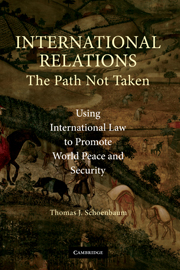Book contents
- Frontmatter
- Contents
- Preface and Overview
- 1 Introduction: Two Very Different Wars in Iraq
- 2 The Twenty-First Century – The End of History or a New Beginning?
- 3 International Power Politics
- 4 A New Global Order Based on International Law and Multilateralism
- 5 Peace and Security: Reinventing the United Nations
- 6 International Political Economy
- 7 International Environmental Protection
- 8 International Human Rights
- 9 International Crimes
- 10 Conclusions
- Index
- References
1 - Introduction: Two Very Different Wars in Iraq
Published online by Cambridge University Press: 23 July 2009
- Frontmatter
- Contents
- Preface and Overview
- 1 Introduction: Two Very Different Wars in Iraq
- 2 The Twenty-First Century – The End of History or a New Beginning?
- 3 International Power Politics
- 4 A New Global Order Based on International Law and Multilateralism
- 5 Peace and Security: Reinventing the United Nations
- 6 International Political Economy
- 7 International Environmental Protection
- 8 International Human Rights
- 9 International Crimes
- 10 Conclusions
- Index
- References
Summary
“Because of the scope of the problems we face, understanding International Law is no longer a legal specialty, it is becoming a duty.”
Sandra Day O'Connor, Associate Justice of the U.S. Supreme Court, October 27, 2004OPERATION DESERT STORM
On January 17, 1991, in the early morning before dawn, two U.S. Air Force Special Operations helicopters lifted off from a base in Saudi Arabia, leading a squadron of Apache gunships. As the aircraft flew low over the dark expanse of desert in southern Iraq, two radar sites came into view; they were instantly obliterated along with their unfortunate personnel.
This began Operation Desert Storm, a massive air campaign followed by a ground assault that chased the forces of Saddam Hussein out of Kuwait. Despite threats by the Iraqi leader that “the mother of all battles” would be a bloodbath for opposition forces and similar fears expressed by some highly placed U.S. civilian and military officials, the Gulf War of 1991 proved to be a cakewalk. The poorly trained, poorly equipped, and demoralized Iraqi army collapsed and surrendered en masse.
The result was an unalloyed success for the United States and the international community. Saddam Hussein was humiliated, and international aggression was turned back. The U.S. military performed in awesome fashion, overcoming the degradation of the war in Vietnam. Under U.N. Resolution 687, adopted by the U.N. Security Council in April 1991, Iraq was compelled to renounce in a verifiable manner all weapons of mass destruction (chemical, biological, and nuclear) and to pay billions of dollars in compensation for the damage caused by the invasion, including reparations for environmental damage.
- Type
- Chapter
- Information
- International RelationsThe Path Not Taken, pp. 1 - 13Publisher: Cambridge University PressPrint publication year: 2006



